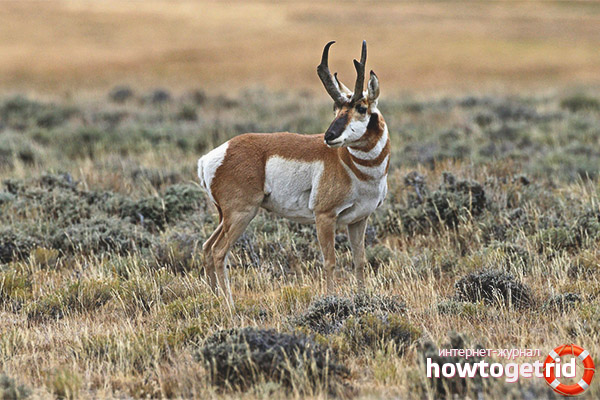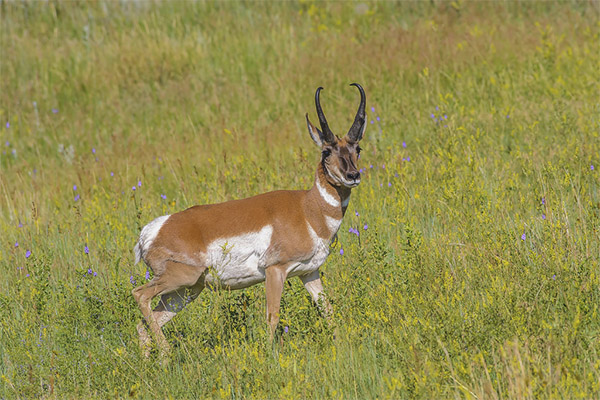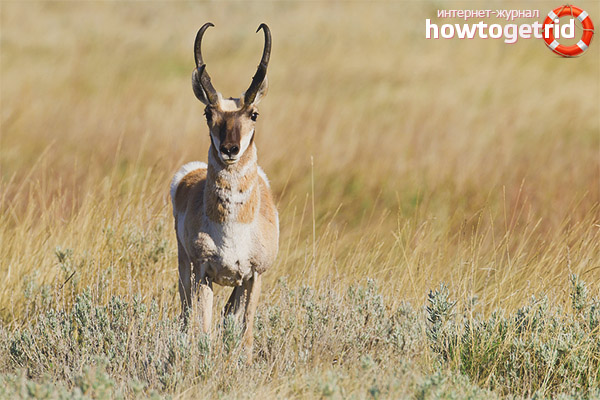The content of the article
A large number of animals, including ungulates, are found in the savannas, forests and prairies of North America. One of the most ancient is the Vilorogian antelope, which has been living on the North American continent since the distant times of the Pliocene (10-12 million years ago). True, in those times there were more than 70 species of these animals, and only one survived to our time. And that, it was almost destroyed in the beginning of the 20th century. But, thank God, people had the wisdom not to destroy this beauty.
Description
Pronghorn antelope immediately resembles two ungulates - a bit of a chamois, a bit of an antelope. The animal is quite slender, you can even say - beautiful, looks something like a chamois. The body is about 130 centimeters long, the height at the withers reaches one meter, and the weight, depending on age, is from 30 to 65 kilograms. Females are usually smaller than males.
The back is colored reddish-brown, the belly and the lower side are white. The throat is decorated with a white speck in the shape of a semicircle.
Muzzle elongated, slightly elongated, like all ungulates. The top is black, which creates the effect of a mask dressed in an animal. Big eyes are able to see absolutely everything around - the animal has a 360 degree view.
On the front paws are pads, consisting of cartilaginous growths, their role is to protect the feet of the animal from damage and wounds caused by sharp prickly stones.
Horns
Once a year, when the rut comes to an end, a change takes place - the pride that has grown over the year is dropped, leaving behind only small bases, on which during the winter new branchy formations are growing. The growth process lasts about 4 months and ends in the spring - the horns, reaching 30 centimeters, no longer stretch, their growth stops.
Habitat
Viloroozhie antelopes are spread throughout North America - from the southern regions of Canada to the northernmost Mexican states. The animal chooses steppe areas with a hilly landscape for living, the main condition is that there is a water source not further 3-5 kilometers from the habitat.
Lifestyle
In the summer, they are kept in small groups, and in the autumn and winter period, the Vilorogi form large (more than a hundred individuals) herds and slowly move around the territory of the mainland to places rich in food and water. Migration can be up to 300 kilometers in length, and always takes the same route — it has remained unchanged for many years. The leader is always the female, and the male goes behind the herd and urges those who are lagging behind and weak.
Upon arrival at a new place rich in fodder, the herd may disband - young grown males organize new groups, while females form separate groups.
Age males live on their own and stay away from the herd, nevertheless, migrating with it.
Animals are very undemanding to water and drink no more than once a day.For a long time, they can do without water at all, they only need to eat succulent plants - this will saturate their bodies with moisture for a long time.
They cannot be definitely referred to as day or night animals - they feed at any time of the day or night, they become especially active during the sunrise. They sleep for an hour or two, having found thickets of low-growing bushes and hiding under them.
The mode of life is as follows: two hours are given for feeding, then an hour and a half - sleep and again feeding until noon. Then a long rest until 16-17 hours, and again feeding until sunset. According to this schedule, the Vilorogi live from generation to generation.
Nutrition
Fawns are one hundred percent herbivores. They eat all the grass growing on the territory of their habitat, moreover, they feed on plants that serve as poison for cows, sheep and other livestock. The diet varies in seasons and depends on the habitat. That is - in the north of the mainland it will differ from what animals feed in the southern regions. As a rule, the food is shrubs, all types of grasses, lichens, cacti growing in the southern regions of the mainland. He likes to pick up the fruits fallen from the trees, gnaws young young shoots with pleasure, eats flowers.Favorite plant is sage.
Breeding

Pronghorn are polygamous animals. Sexual maturity occurs in 15-16 months, but males enter into marriage only in the fourth year of life, and females - in the third. Gon them begins in August and lasts about two weeks. The herd falls apart, and the males begin to fight for the possession of the female, the fights turn out to be quite serious and traumatic, sometimes even end in tragedy - one of the opponents dies. The winner collects a small harem of up to 15 females, which must be protected from rivals.
Children
Pregnancy lasts around eight months. As a rule, one cub is born, sometimes twins. The newborn calf is absolutely helpless, not very large - about 4 kilograms, has a grayish-brown color. At first, they hide from the dangers in the grass thickets where they lie, because the legs are very weak and there is no strength to stand. Mother comes to them four times a day and feeds her with milk. Three weeks after the birth, the calf is already eating grass, but the mother continues to feed for up to three months.
In one and a half month the got strong cub joins in herd.After the mother stops feeding, children are almost like adults and lead the same way of life.
Security
On Viloroga, people hunted a lot and often, which led to a significant reduction of this species. But the US government has adopted strict laws governing the shooting and trapping of animals. Due to this, the number increased to nearly a million individuals and the disappearance of the species is not threatened. However, the pronghorn is listed in the International Red Book.
Interesting Facts
The difference between females and males is manifested even in maternal feeding: the mother feeds female children 15-20 days longer than boys.
Although these antelopes are able to jump well, any obstacle higher than one meter represents an insurmountable obstacle for them that cannot be overcome. So, finding themselves on a fenced plot, animals may well die of hunger, even if there is a flowering meadow outside.
Vilorogi communicate with each other using sounds.The cubs emit bleating, summoning the mother, adult sexually mature males, entering into a fight, loudly and protractedly roar, mothers call the babies too tender bleating.












To send